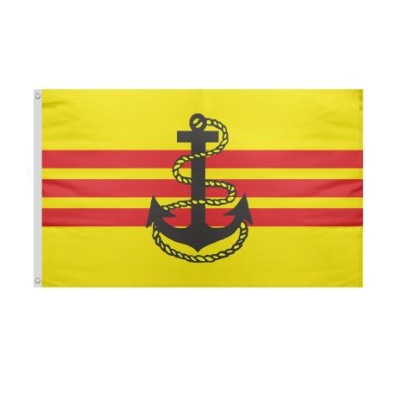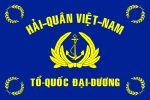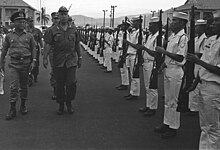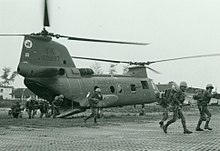

Emblem of the South Vietnamese Navy


Thượng Viện Mỹ vừa chuẩn thuận cho cậu bé Việt Nam chạy giặc 30/4/75 lên cấp tướng
https://www.youtube.com/live/sAoG9IIolGE?si=wMVeIoxybsTvGJ2-
Cựu Phó Đề Đốc Nguyễn Từ Huấn, Cố vấn cao cấp Bộ tư lệnh kỹ thuật hàng hải Hải quân Hoa Kỳ (NAVSEA)
18/04/2024
Nguyễn Quân

Phó đề đốc Nguyễn Từ Huấn (Ảnh của navy.mil/Leadership)
Sau 30 năm phục vụ Hải Quân, ba năm mang cấp Phó đề đốc, ông Nguyễn Từ Huấn, nguyên Chỉ huy phó an ninh mạng kỹ thuật điện tử, Bộ tư lệnh kỹ thuật hàng hải Hải quân (NAVSEA) hồi hưu vào tháng 10 năm 2022. Dù đã rời Hải quân, Cựu Phó đề đốc Nguyễn Từ Huấn vinh dự được Hải quân bổ nhiệm trong vai trò Cố vấn cao cấp cho Bộ tư lệnh kỹ thuật hàng hải Hải quân Hoa Kỳ, đơn vị nơi ông phục vụ trước khi hồi hưu. Tháng 8 năm 2023, ông cũng được Cục Nghiên cứu Quốc gia Châu Á (NBR) mời tham dự vào Hội đồng Quản trị, theo thông báo từ NBR.
Cục Nghiên cứu Quốc gia Châu Á là một tổ chức nghiên cứu độc lập, có trụ sở tại Seattle và Washington, D.C. NBR giúp Giới chức Hoa Kỳ hiểu rõ hơn về Châu Á, thực hiện chính sách phù hợp và hoàn chỉnh hơn. Ông John Rindlaub, Chủ tịch Hột đồng quản trị NBR phát biểu: Chúng tôi hân hạnh được chào đón Cữu Phó đề đốc Nguyễn Từ Huấn, người có chuyên môn về an ninh mạng và chuyển đổi kỹ thuật số trong hoạt động quân sự sẽ là nguồn lực quý giá cho NBR vào thời điểm quan trọng đối với an ninh quốc gia Hoa Kỳ và tương lai của quan hệ Hoa Kỳ-Châu Á”.

Thiếu Tướng Lapthe C. Flora, Phó đề đốc Nguyễn Từ Huấn và Thiếu Tướng Lương Xuân Việt (Ảnh của nguoiviet.com năm 2019).
Phó đề đốc Nguyễn Từ Huấn là người Mỹ gốc Việt đầu tiên được thăng cấp Phó đề đốc Hải quân Hoa Kỳ và là một trong sáuvị tướng Hoa Kỳ gốc Việt. Năm vị tướng gốc Việt khác gồm có:
- Thiếu tướng Lapthe C. Flora, Phụ tá Tư lệnh vệ binh Quốc gia Arlington, Virginia.
- Thiếu tướng William H. Seely III, Chỉ huy trưởng tình báo, Bộ tư lệnh Thủy quân lục chiến Hoa Kỳ.
- Thiếu tướng John R Adwards, Giám đốc chiến lược Quốc phòng, Hội đồng an ninh Quốc gia Tòa Bạch Ốc, Washington, D.C.
- Tân Phó đề đốc Tuấn Nguyễn, Hải Quân Hoa Kỳ.
- Thiếu tướng Lương Xuân Việt, nguyên tư lệnh lục quân Hoa Kỳ tại Nhật Bản, hồi hưu vào tháng 6 năm 2021.

Hình
Phó đề đốc Nguyễn Từ Huấn (Ảnh của reddit.com).
Phó đề đốc Nguyễn Từ Huấn tốt nghiệp Đại học Oklahoma State University với văn bằng Cử nhân khoa học kỹ thuật điên tử năm 1981, và gia nhập Hải quân qua chương trình Sĩ quan cơ khí trừ bị ( Reserve Engineering Duty Officer program) năm 1993. Ông đã hoàn tất các Văn bằng Cao học tại các trường Đại học: Văn bằng cao học kỹ thuật điện tử, Đại học Southern Methodist University; Văn bằng Cao học kỹ thuật, Đại học Purdue University; và Văn bằng Cao học tin học, Đại học Carnegie Mellon University.
Sau 30 năm phục vụ các đơn vị Hải quân, Phó đề đốc Nguyễn Từ Huấn đã được ân thưởng các loại huy chương cao quý như:
3 huy chương Legion of Merit,
1 huy chương Bronze Star Medal;
1 huy chương Meritorious Service Medal;
2 huy chương Navy and Marine Corps Commendation Medal; Và
2 huy chương Navy and Marine Corps Achievement Medal.
Nguyễn Quân
Nguồn: navy.mil/Leadership; nbr.org; navsea.navy.mil; en.wikipedia.org; bienxua-Phó Đề Đốc Nguyễn Từ Huấn về hưu sau 30 năm phục vụ Hải Quân Hoa Kỳ.
Republic of Vietnam Navy
|
Republic of Vietnam Navy Hải quân Việt Nam Cộng hòa | |
|---|---|

Emblem of the South Vietnamese Navy
| |
| Founded | 1952 |
| Disbanded | 30 April 1975 |
| Country | |
| Branch | Navy |
| Role | Sea control |
| Size | 42,000 men, 1,400 ships, boats and other vessels (1973) |
| Part of | |
| Garrison/HQ | Saigon, South Vietnam |
| Nickname (s) | "HQVNCH" ("RVNN" in English) |
| Motto (s) | Tổ quốc — Đại dương ("The Fatherland — The Ocean") |
| March | Hải quân Việt Nam hành khúc |
| Anniversaries | 20 August |
| Engagements | Vietnam War Cambodian Civil War Battle of the Paracel Islands |
| Commanders | |
| Notable commanders | Trần Văn Chơn Cao Văn Viên Lâm Ngươn Tánh Chung Tấn Cang |
| Insignia | |
| Flag |  |
| Naval ensign |  |
| Flag of Saint Trần |  |


The Republic of Vietnam Navy (RVNN; Vietnamese: Hải quân Việt Nam Cộng hòa - HQVNCH; Chữ Hán: 海軍越南共和) was the naval branch of the South Vietnamese military, the official armed forces of the former Republic of Vietnam (or South Vietnam) from 1955 to 1975. The early fleet consisted of boats from France; after 1955, and the transfer of the armed forces to Vietnamese control, the fleet was supplied from the United States. With American assistance, in 1972 the VNN became the largest Southeast Asian navy and, by some estimates, the fourth largest navy in the world, just behind the Soviet Union, the United States and the People's Republic of China,[1] with 42,000 personnel, 672 amphibious ships and craft, 20 mine warfare vessels, 450 patrol craft, 56 service craft, and 242 junks. Other sources state that VNN was the ninth largest navy in the world.[2] The Republic of Vietnam Navy was responsible for the protection of the country's national waters, islands, and interests of its maritime economy, as well as for the co-ordination of maritime police, customs service and the maritime border defence force.
The Republic of Vietnam Navy disbanded in 1975 with the collapse of South Vietnam, and North Vietnam's victory in the Vietnam War. Most of its fleet was captured in port, but a small fleet of vessels, led by Captain Đỗ Kiếm and Richard L. Armitage of the Defense Attaché Office, Saigon, escaped to Thailand and surrendered themselves to American naval forces there. Some of these RVNN vessels were scuttled upon reaching the open sea, while others continued their service with the Philippine Navy.
History
Expansion of the VNN
| Year | Personnel | Vessels |
|---|---|---|
| 1955 | 2,000 | 22 |
| 1961 | 5,000 | 220 |
| 1964 | 8,100 | ? |
| 1967 | 16,300 | 639 |
| 1973 | 42,000 | 1,400 |
Politics and coups
VNN commander Captain Hồ Tấn Quyền, was a loyal supporter of President Ngô Đình Diệm. In order to prevent him supporting Diệm in the 1963 South Vietnamese coup, he was executed by fellow VNN officers on the morning of 1 November 1963.[3]
During the 1965 South Vietnamese coup, rebel forces surrounded the VNN headquarters at the Saigon Naval Shipyard, apparently in an attempt to capture VNN commander Chung Tấn Cang. However, this was unsuccessful and Cang moved the fleet to Nhà Bè Base to prevent the rebels from seizing the ships.[4]
Vietnamization
In early 1969, President Richard M. Nixon formally adopted the policy of "Vietnamization". The naval part, called ACTOV ("Accelerated Turnover to the Vietnamese"), involved the phased transfer to Vietnam of the U.S. river and coastal fleet, as well as operational command over various operations. In mid-1969, the VNN took sole responsibility for river assault operations when the U.S. Mobile Riverine Force stood down and transferred 64 riverine assault craft to the VNN. On 10 October 1969, 80 Patrol Boat, Rivers (PBR) were transferred to the VNN at the Saigon Naval Shipyard, the PBRs were divided into four River Patrol Groups (RPGs) as part of Task Force 212.[5]
The end
On 19 January 1974, four VNN ships fought a battle with four ships of the Chinese People's Liberation Army Navy over ownership of the Paracel Islands, 200 nautical miles (370 km) due east of Đà Nẵng. The VNN ship Nhựt Tảo (HQ-10) was sunk, Lý Thường Kiệt (HQ-16) was heavily damaged, and both Trần Khánh Dư (HQ-4) and Trần Bình Trọng (HQ-5) suffered light damage. The Chinese captured and occupied the islands.
In the spring of 1975, North Vietnamese forces occupied all of northern and central South Vietnam, and finally Saigon fell on 30 April 1975. However, Captain Kiem Do had secretly planned and then carried out the evacuation of a flotilla of thirty-five Vietnam Navy and other vessels, with 30,000 sailors, their families, and other civilians on board, and joined the U.S. Seventh Fleet when it sailed for Subic Bay, Philippines.[6] Most of the Vietnamese ships were later taken into the Philippine Navy,[7] though the LSM Lam Giang (HQ-402), fuel barge HQ-474, and gunboat Kéo Ngựa (HQ-604) were scuttled after reaching the open sea and transferring their cargo of refugees and their crews to other ships.[8]
After the war, about 1,300 former VNN vessels including junks were used by the Vietnam People's Navy, making it the largest Southeast Asian navy in the mid-1980s. Some personnel were retained, with 80% of the Ham Tu Brigade in the VPN’s Bach Dang Fleet being South Vietnamese veterans. [9]
Organization
Fleet Command
VNN Fleet Command was directly responsible to the VNN Chief of Naval Operations for the readiness of ships and craft. The Fleet Commander assigned and scheduled ships to operate in the Coastal Zones, Riverine Areas, and the Rung Sat Special Zone. All Fleet Command ships were home ported in Saigon and normally returned there after deployments. When deployed, operational control was assumed by the respective zone or area commander, and the ships operated from the following ports:[10]
- I Coastal Zone – Đà Nẵng
- II Coastal Zone – Nha Trang/Qui Nhơn
- III Coastal Zone – Vũng Tàu/Cần Thơ/Châu Đức
- IV Coastal Zone – An Thoi/Phú Quốc
- Rung Sat Special Zone – Nhà Bè
Flotillas[edit]
The VNN was organized into two flotillas: a patrol flotilla and a logistics flotilla.[10] Flotilla I was composed of patrol ships, organized into four squadrons. The patrol types included LSSLs and LSILs which normally operated only in Riverine Areas or the Rung Sat Special Zone; though occasionally they were assigned the four coastal zones. Operational commitments required that half of the patrol flotilla be deployed at all times, with a boat typically spending 40 to 50 days at sea on each patrol. Fleet Command patrol ships assigned to the riverine areas provided naval gunfire support as well as patrolling the main waterways in the riverine areas. One river patrol unit was assigned as convoy escort on the Mekong River to and from the Cambodian border.[10]
Flotilla II was composed of logistic ships, divided into two squadrons, supporting the naval units and bases throughout South Vietnam. Logistic ships were under the administrative control of the Fleet Commander, and under the operational control of the VNN Deputy Chief of Staff for Logistics who acted upon orders from the Central Logistics Command of the Joint General Staff.[10]

The VNN also have under them a contingent of Naval Infantry or Marine Division formed in 1954 by then Prime Minister Ngo Dinh Diem and trained by the French Commandos Marine
UDT-(LDNN)
The South Vietnamese Navy had a small frogman group, the Liên Đoàn Người Nhái.
Training
The VNN training establishment consisted of a Training Bureau located at VNN Headquarters, with Training Centers located in Saigon, Nha Trang, and Cam Ranh Bay.[10]
Ranks and insignia
Commissioned officer ranks
The rank insignia of commissioned officers.
| Rank group | General / flag officers | Senior officers | Junior officers | Officer cadet | ||||||||||||||||||||||||||||||||
|---|---|---|---|---|---|---|---|---|---|---|---|---|---|---|---|---|---|---|---|---|---|---|---|---|---|---|---|---|---|---|---|---|---|---|---|---|
(1955-1963)[11] |

|

|

|

|

|

|

|

|

|

|

|

| ||||||||||||||||||||||||
| Đô đốc | Phó đô đốc | Đề đốc | Phó đề đốc | Đại tá | Trung tá | Thiếu tá | Đại úy | Trung úy | Thiếu úy | Chuẩn úy | Sinh viên sĩ quan | |||||||||||||||||||||||||
(1964-1975)[12] |

|

|

|

|

|

|

|

|

|

|

|

|

| |||||||||||||||||||||||
| Thủy sư Đô đốc | Đô đốc | Phó đô đốc | Đề đốc | Phó đề đốc | Đại tá | Trung tá | Thiếu tá | Đại úy | Trung úy | Thiếu úy | Chuẩn úy | Sinh viên sĩ quan | ||||||||||||||||||||||||
Other ranks
The rank insignia of non-commissioned officers and enlisted personnel.
| Rank group | Senior NCOs | Junior NCOs | Enlisted | |||||||||||||||||||||||||||||||||
|---|---|---|---|---|---|---|---|---|---|---|---|---|---|---|---|---|---|---|---|---|---|---|---|---|---|---|---|---|---|---|---|---|---|---|---|---|
(1954–1967)[11] |

|

|

|

|
No insignia | |||||||||||||||||||||||||||||||
| Thượng sĩ nhất | Thượng sĩ | Trung sĩ nhất | Trung sĩ | Hạ sĩ nhất | Hạ sĩ | Binh nhất | Binh nhì | |||||||||||||||||||||||||||||
(1967–1975)[12] |

|

|

|

|
No insignia | |||||||||||||||||||||||||||||||
| Thượng sĩ nhất | Thượng sĩ | Trung sĩ nhất | Trung sĩ | Hạ sĩ nhất | Hạ sĩ | Binh nhất | Binh nhì | |||||||||||||||||||||||||||||
Commanders of the VNN
- Commander (later Navy Captain) Lê Quang Mỹ, 1955–57
- Commander Trần Văn Chơn, 1957–59
- Navy Captain Hồ Tấn Quyền, 1959–63
- Navy Captain (later Vice Admiral) Chung Tấn Cang, 1963–65
- Navy Captain Trần Văn Phấn, 1965–66
- Lieutenant General Cao Văn Viên, September – November 1966 - Temporary after Coup d'État
- Navy Captain (later Rear Admiral) Trần Văn Chơn, 1966–74
- Rear Admiral Lâm Ngươn Tánh, for 2 months between 1974 and 1975
- Vice Admiral Chung Tấn Cang, 24 March – 29 April 1975
See also[edit]
- Ships of the Republic of Vietnam Navy
- Army of the Republic of Vietnam
- Republic of Vietnam Military Forces
- Republic of Vietnam Air Force
- Republic of Vietnam Marine Division
- Royal Lao Navy
- Khmer National Navy
References
- ^ Fiscal Year 1972 Authorization for Military Procurement: Research and Development, Construction and Real Estate Acquisition for the Safeguard ABM, and Reserve Strengths. Hearings, Ninety-second Congress, First Session, on S. 939 (H.R. 8687). U.S. Government Printing Office. 1971.
- ^ "All Hands". 1970.
- ^ Hammer, Ellen J. (1987). A Death in November: America in Vietnam, 1963. E. P. Dutton. p. 284. ISBN 0-525-24210-4.
- ^ "Hours in an Anxious Saigon: How Anti-Khánh Coup Failed". The New York Times. 1965-02-21. p. 2.
- ^ "Headquarters MACV Monthly Summary October 1969" (PDF). Headquarters United States Military Assistance Command, Vietnam. 1 January 1970. p. 22. Archived from the original (PDF) on November 3, 2022. Retrieved 25 March 2020.
 This article incorporates text from this source, which is in the public domain.
This article incorporates text from this source, which is in the public domain.
- ^ Do, Kiem; Kane, Julie (1998). Counterpart: A South Vietnamese Naval Officer's War. Annapolis: Naval Institute Press. ISBN 978-1-55750-181-3.
Julie Kane.
- ^ Jane's Fighting Ships. 1975–76. p. 658 ADDENDA.
- ^ Cima, R.J (1987). Vietnam: A Country Study. Federal Research Division, Library of Congress. p. 279.
- ^ a b c d e Nach, Jim (January 1974). Command Histories and Historical Sketches of the Republic of Viet Nam Armed Forces Divisions (PDF). Archived from the original (PDF) on October 11, 2006.
- ^ a b Armed Forces Information and Education (1960). Military Uniforms: A Manual of United States and Foreign Armed Forces Uniforms, Insignia and Organizations (DOD PAM 1-14) (3rd ed.). Department of Defense. p. 64. Retrieved 2 July 2022.
- ^ a b Armed Forces Information and Education (1968). Uniforms of Seven Allies (DOD GEN-30). Department of Defense. pp. 26–28. Retrieved 2 July 2022.
Bibliography
- Bogart, Charles H. (2003). "The Navy of the Republic of Vietnam". Warship International. XL (2): 175–188. ISSN 0043-0374.
- This article incorporates material translated from the corresponding page in the Vietnamese Wikipedia.
External links[edit]
- US Naval Historical Center : Navy of the Republic of Vietnam
- vietnamresearch.com: Republic of Vietnam Navy
This page was last edited on 8 March 2024, at 14:32 (UTC).
Quân đội nhân dân cộng sản Việt Nam (Vietnamese Communist Army) đặt đảng chính trị lên trên hết, trung thành với đảng cộng sản, với lý thuyết Mác Lê, Họ chiến đấu vì đảng viên trong chủ nghĩa xã hội của quốc tế đảng cộng sản đại đồng, không biên giới đất nước và quốc gia phải hy sinh cho cộng sản quốc tế đại đồng của đảng.
Chúng tôi không coi Quân Đội Nhân Dân Việt cộng (Vietnamese Communist Army) là một quân đội cho Việt Nam, mà nó được dựng lên cho quốc tế cộng sản, họ tuân theo luật của đảng cộng sản, và Việt Nam là một chi nhánh cộng sản ở đất Việt Nam, phải tuân theo luật của Trung cộng, nên quân phục của Việt cộng và Trung cộng rất giống nhau, chỉ khác là quân đội Việt cộng viết bằng tiếng Việt và quân đội Trung cộng viết bằng chữ Hán. Việt cộng theo Mao Đích, Le nin níck, max xick.
Trung cộng có hai đứa em: đó là cộng sản Việt cộng và cộng sản Campuchia, nhưng Trung cộng luôn dùng đứa em Cam cộng để đâm hông, thọc sườn thằng Việt cộng vì thằng Việt cộng có đường biển để Trung cộng dùng đường biển chiếm cả Đông Nam Á, trong đó có Cam cộng.
Việt cộng nay phải chịu trận vì kinh tế bị trung cộng thâu tóm. Quân sự thì súng ống vũ khí đều do Trung cộng cung cấp nay nó không đưa vì Việt cộng đã chiếm miền nam được cho Trung cộng rồi, Nga viện trợ hả? Nay Nga lao vào cuộc chiến chiếm đất của nước bạn Ukcrain, nên thiếu vũ khí, không viện trợ cho Việt cộng được nữa.
"Đất lành, chim đậu". Rất đúng! Nhưng chim Việt lũ lượt bay đi nhiều, từng đợt lớn, đến hôm nay và chim "Đại Hán" rũ nhau đậu "du lịch di dân" ở nước ta? Có cái gì sai không? Và đàn bà con gái Việt sang Tàu để đẻ mướn làm loãng dòng máu Việt oai hùng? Để làm dâu nước Tàu sống cô lập tại những vùng quê hoang vắng? Nhưng không có gái Tàu nào chịu lấy chồng Việt, có cái gì sai không?
Một cuộc "di dân" có chiến lược, có kế hoạch, có chính sách: "Chiếm đất không có tiếng súng, không đổ máu" của Đại Hán từ ngàn năm nay với người Việt, nước Việt? Có cái gì sai không?
Đoc thêm:
Hải Quân VNCH
Hồi Ký Người Nhái VNCH
https://caybut2.blogspot.com/2015/06/hoi-ky-nguoi-nhai-nn-le-inh-vao-nam.html
RVN South Vietnam Navy Frogmen Navy Seal

No comments:
Post a Comment